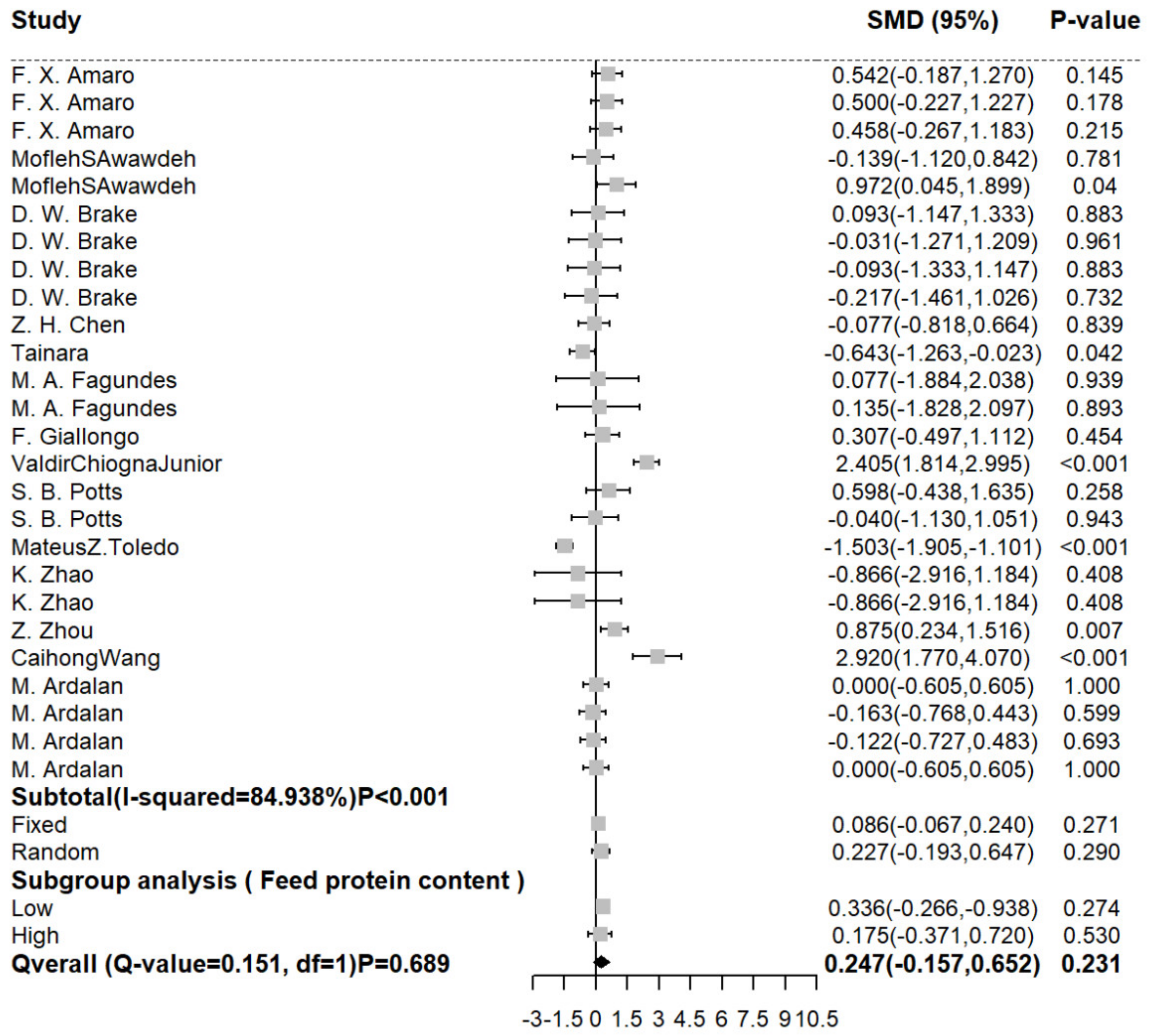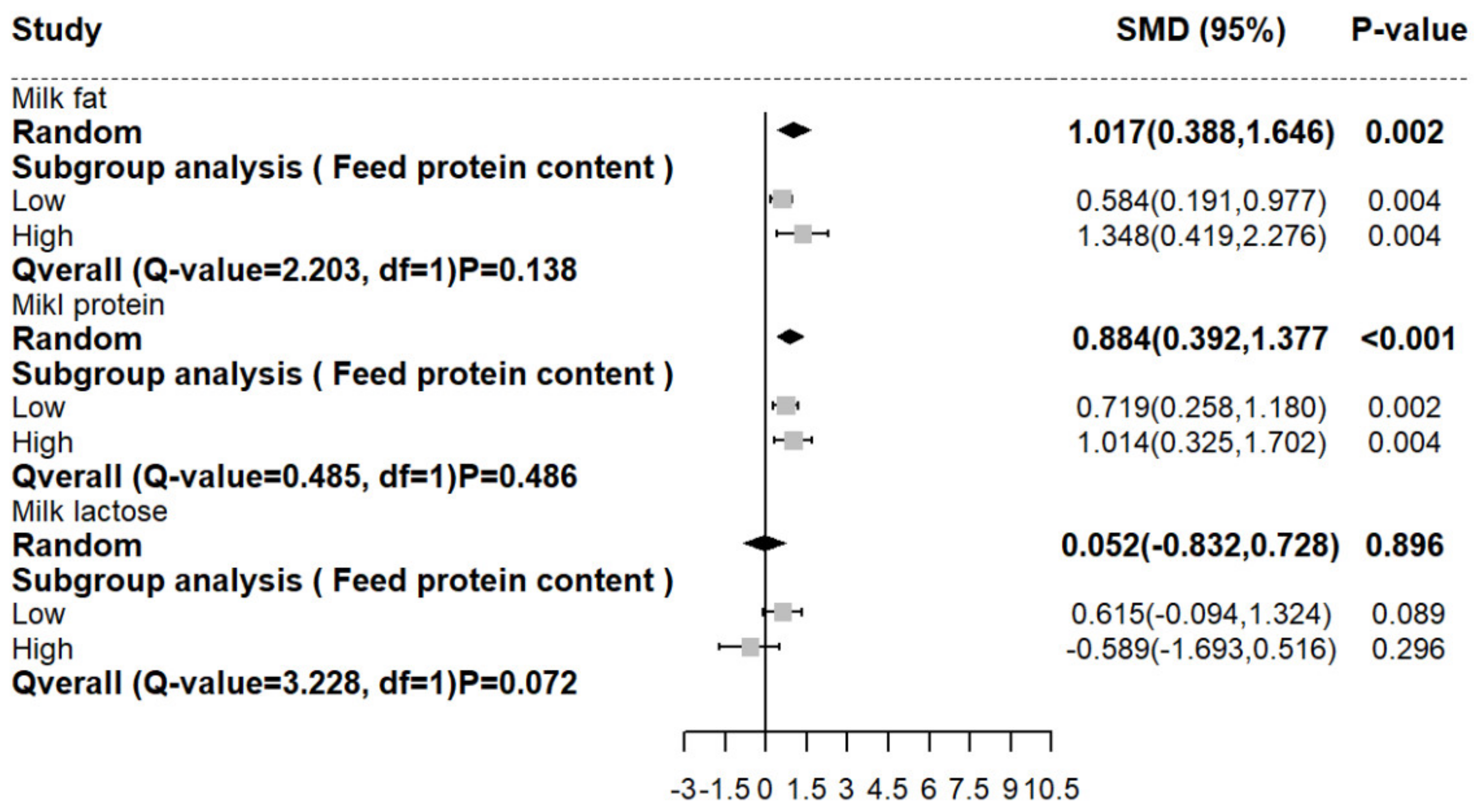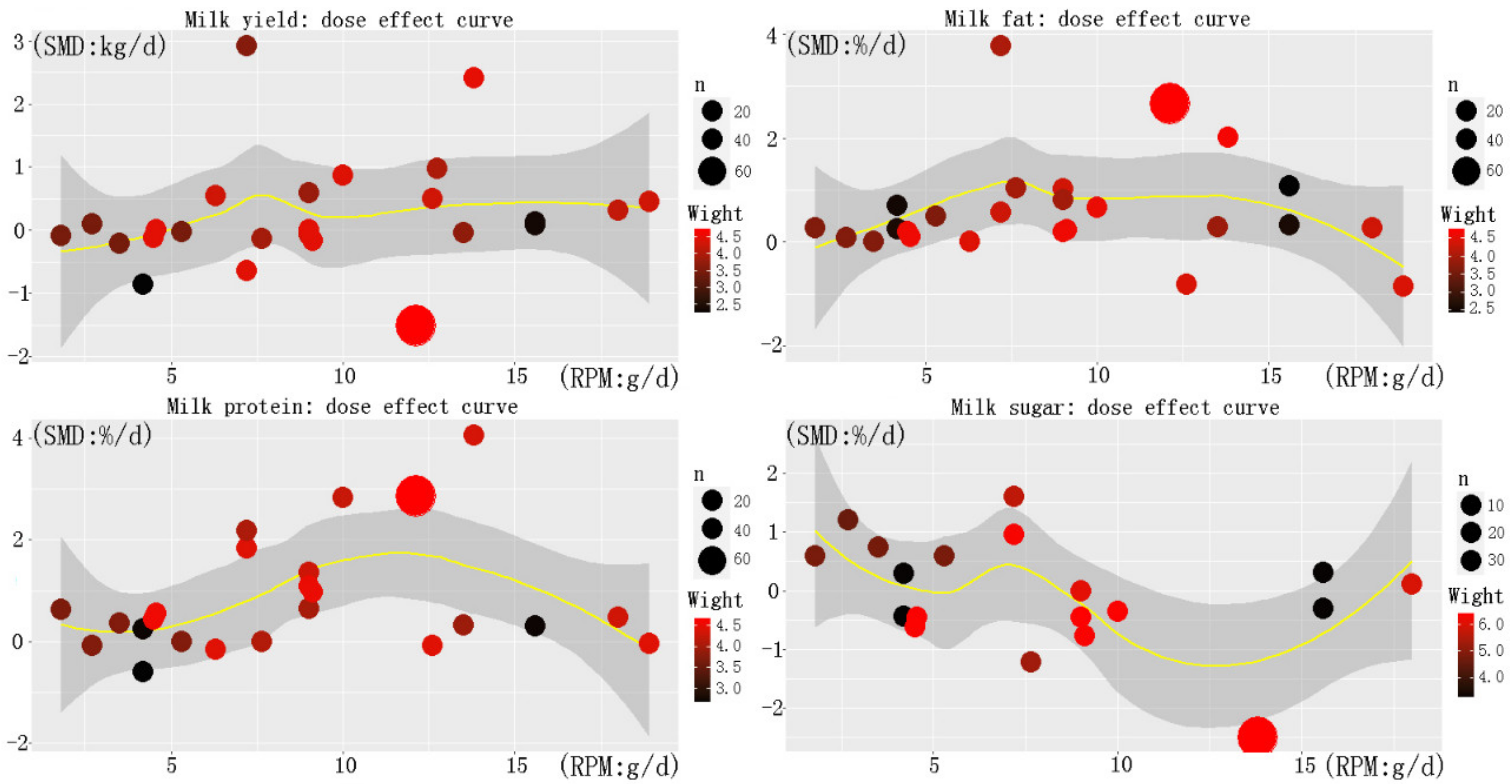Meta-Analysis of Rumen-Protected Methionine in Milk Production and Composition of Dairy Cows
Abstract
:Simple Summary
Abstract
1. Introduction
2. Materials and Methods
2.1. Retrieval Strategy
2.1.1. Inclusion and Exclusion Criteria
2.1.2. Information and Data Extraction
2.2. Statistical Analysis
2.2.1. Statistical Software
2.2.2. Effect and Heterogeneity
2.2.3. Weighting
2.2.4. Sensitivity Analysis and Meta-Regression
2.2.5. Publication Bias and Dose–Response Curve
3. Results
3.1. Included Studies
3.2. Publication Deviation Analysis
3.3. The Effect of RPM on the Milk Yield of Dairy Cows
3.4. The Effects of RPM on the Milk Compositions of Dairy Cows
3.5. Sensitivity Analysis and Meta-Regression Analysis
3.6. Prediction of Optimum Addition of RPM
4. Discussion
5. Conclusions
Author Contributions
Funding
Institutional Review Board Statement
Informed Consent Statement
Data Availability Statement
Conflicts of Interest
Appendix A
| Mean | Maximum | Minimum | Standard Deviation | |||||
|---|---|---|---|---|---|---|---|---|
| Control | Met | Control | Met | Control | Met | Control | Met | |
| Milk yield | 38.5 | 38.7 | 46.4 | 46.4 | 23.3 | 23.2 | 1.35 | 1.35 |
| Milk fat | 3.4 | 3.5 | 4.0 | 4.2 | 2.8 | 2.8 | 0.06 | 0.08 |
| Milk protein | 3.0 | 3.1 | 3.6 | 3.5 | 2.77 | 2.81 | 0.49 | 0.49 |
| Milk lactose | 4.9 | 4.9 | 5.23 | 5.25 | 4.6 | 4.54 | 0.04 | 0.04 |
| Items | Mean 1 | Kurtosis 2 |
|---|---|---|
| Milk yield | 0.179 | 3.678 |
| Milk fat | 0.614 | 3.351 |
| Milk protein | 0.817 | 3.817 |
| Milk lactose | −0.0376 | 3.439 |
References
- Brake, D.W.; Titgemeyer, E.C.; Brouk, M.J.; Macgregor, C.A.; Smith, J.F.; Bradford, B.J. Availability to lactating dairy cows of methionine added to soy lecithins and mixed with a mechanically extracted soybean meal. J. Dairy Sci. 2013, 96, 3064–3074. [Google Scholar] [CrossRef] [PubMed] [Green Version]
- Awawdeh, M.S. Rumen-protected methionine and lysine: Effects on milk production and plasma amino acids of dairy cows with reference to metabolisable protein status. J. Dairy Res. 2016, 83, 151–155. [Google Scholar] [CrossRef] [PubMed]
- Xiong, C.; Zhang, L.; Zhou, X.; Jiang, X.; Zhu, J.; Gon, S.; Deng, C. Effect of Protected Methionine on Productive Performance of Chinese Holstein in the Middle of Lactation. China Dairy Cattle 2004, 6, 30–32. [Google Scholar]
- Sun, H.; Zhang, X.; Wang, X.; Luo, Y.; Bi, X.; Li, H.; Zhang, X.; Zhao, S. Effect of Supplementing Rumen Protected Methionine on Milk Performance of Dairy Cow and Economic Benefits Analysis. China Dairy Cattle 2010, 11, 7–11. [Google Scholar]
- Amaro, F.X.; Kim, D.; Restelatto, R.; Carvalho, P.; Arriola, K.; Duvalsaint, E.; Cervantes, A.; Jiang, Y.; Agarussi, M.; Silva, V.; et al. Lactational performance of dairy cows in response to supplementing N-acetyl-l-methionine as source of rumen-protected methionine. J. Dairy Sci. 2022, 105, 2301–2314. [Google Scholar] [CrossRef]
- Xu, B.; Zhu, L.; Fu, J.; Li, Z.; Wang, Y.; Jin, M. Overall assessment of fermented feed for pigs: A series of meta-analyses. J. Anim. Sci. 2019, 97, 4810–4821. [Google Scholar] [CrossRef]
- Li, Z.; Xu, B.C.; Wang, Y.Z. Application of Meta-Analysis in Performance Evaluation. China J. Anim. Nutr. 2020, 3, 32. [Google Scholar]
- Higgins, J.P.; Thompson, S.G.; Deeks, J.J.; Altman, D.G. Measuring inconsistency in meta-analyses. BMJ 2003, 327, 557–560. [Google Scholar] [CrossRef] [Green Version]
- Tipton, E. Small sample adjustments for robust variance estimation with meta-regression. Psychol. Methods 2015, 20, 375. [Google Scholar] [CrossRef]
- Vesterinen, H.; Sena, E.; Egan, K.; Hirst, T.; Churolov, L.; Currie, G.; Antonic-Baker, A.; Howells, D.; Macleod, M.R. Meta-analysis of data from animal studies: A practical guide. J. Neurosci. Methods 2014, 221, 92–102. [Google Scholar] [CrossRef] [Green Version]
- Light, R.J.; Pillemer, D.B. Summing Up: The Science of Reviewing Research; Harvard University Press: Seattle, WA, USA, 1984; Volume 12, pp. 302–308. [Google Scholar]
- Egger, M.; Smith, G.D.; Schneider, M.; Minder, C. Bias in meta-analysis detected by a simple, graphical test. BMJ 1997, 315, 629–634. [Google Scholar] [CrossRef] [PubMed] [Green Version]
- Wang, C.; Liu, H.; Wang, C.; Liu, J.; Liu, H. Effects of Dietary Rumen-Protected Betaine on Lactation Performance and Serum Metabolites of Mid-lactation Holstein Dairy Cows. J. Agric. Food Chem. 2020, 68, 13154–13159. [Google Scholar] [CrossRef] [PubMed]
- Chen, Z.H.; Broderick, G.A.; Luchini, N.D.; Sloan, B.; Devillard, E. Effect of feeding different sources of rumen-protected methionine on milk production and N-utilization in lactating dairy cows. J. Dairy Sci. 2011, 94, 1978–1988. [Google Scholar] [CrossRef] [PubMed]
- Michelotti, T.C.A.; Pacheco, H.A.; Leão, G.F.M.; Lopes, F.; Osorio, J.S.; de Almeida, R. Effects of rumen-protected methionine supplementation on dairy cows during early postpartum. J. Appl. Anim. Res. 2021, 49, 257–263. [Google Scholar] [CrossRef]
- Fagundes, M.A.; Yang, S.Y.; Eun, J.S.; Hall, J.; Moon, J.; Park, J. Influence of supplementing a methionine derivative, N-acetyl-l-methionine, in dairy diets on production and ruminal fermentation by lactating cows during early to mid lactation. J. Dairy Sci. 2018, 101, 7082–7094. [Google Scholar] [CrossRef]
- Giallongo, F.; Harper, M.T.; Oh, J.; Lopes, J.C.; Lapierre, H.; Patton, R.A.; Parys, C.; Shinzato, I.; Hristov, A.N. Effects of rumen-protected methionine, lysine, and histidine on lactation performance of dairy cows. J. Dairy Sci. 2016, 99, 4437–4452. [Google Scholar] [CrossRef] [Green Version]
- Junior, V.C.; Lopes, F.; Schwab, C.G.; Toledo, M.Z.; Collao-Saenz, E.A. Effects of rumen-protected methionine supplementation on the performance of high production dairy cows in the tropics. PLoS ONE 2021, 16, e0243953. [Google Scholar] [CrossRef]
- Ardalan, M.; Vargas-Rodriguez, C.F.; Zanton, G.I.; Vázquez-Añón, M.; Bradford, B.J.; Titgemeyer, E.C. Relative availability of metabolizable methionine from 2 ruminally protected sources of methionine fed to lactating dairy cattle. J. Dairy Sci. 2021, 104, 1811–1822. [Google Scholar] [CrossRef]
- Potts, S.B.; Scholte, C.M.; Moyes, K.M.; Erdman, R.A. Production responses to rumen-protected choline and methionine supplemented during the periparturient period differ for primi- and multiparous cows. J. Dairy Sci. 2020, 103, 6070–6086. [Google Scholar] [CrossRef]
- Toledo, M.Z.; Baez, G.M.; Garcia-Guerra, A.; Lobos, N.E.; Guenther, J.N.; Trevisol, E.; Luchini, D.; Shaver, R.D.; Wiltbank, M.C. Effect of feeding rumen-protected methionine on productive and reproductive performance of dairy cows. PLoS ONE 2017, 12, e0189117. [Google Scholar] [CrossRef] [Green Version]
- Zhao, K.; Liu, W.; Lin, X.Y.; Hu, Z.; Yan, Z.; Wang, Y.; Shi, K.; Liu, G.; Wang, Z. Effects of rumen-protected methionine and other essential amino acid supplementation on milk and milk component yields in lactating Holstein cows. J. Dairy Sci. 2019, 102, 7936–7947. [Google Scholar] [CrossRef]
- Zhou, Z.; Vailati-Riboni, M.; Trevisi, E.; Drackley, J.K.; Luchini, D.N.; Loor, J.J. Better postpartal performance in dairy cows supplemented with rumen-protected methionine compared with choline during the peripartal period. J. Dairy Sci. 2016, 99, 8716–8732. [Google Scholar] [CrossRef] [Green Version]
- Trináctý, J.; Krízová, L.; Richter, M.; Černý, V.; Říha, J. Effect of rumen-protected methionine, lysine or both on milk production and plasma amino acids of high-yielding dairy cows. Czech J. Anim. Sci. 2009, 06, 239–248. [Google Scholar] [CrossRef] [Green Version]
- Wang, C.; Liu, H.Y.; Wang, Y.M.; Yang, Z.Q.; Liu, J.X.; Wu, Y.M.; Yan, T.; Ye, H.W. Effects of dietary supplementation of methionine and lysine on milk production and nitrogen utilization in dairy cows. J. Dairy Sci. 2010, 8, 3661–3670. [Google Scholar] [CrossRef]
- Robinson, P.H. Impacts of manipulating ration metabolizable lysine and methionine levels on the performance of lactating dairy cows: A systematic review of the literature. Livest. Sci. 2010, 127, 115–126. [Google Scholar] [CrossRef]
- Wang, Y.; Hu, X.; Li, H.; Lui, Y. Feeding Experiment of Smartaminc for Improving Dairy Cow’s Production Performances. J. Dairy Sci. Technol. 2005, 27, 33–35. [Google Scholar]
- Wang, J.; Wan, W.; Xu, G.; Cui, G. Influence of protective Methionine on Productivity of Cows. Chin. Dairy Cow 2003, 1, 15–17. [Google Scholar]
- Samuelson, D.J.; Denise, S.K.; Roffler, R. Response of Holstein and Brown Swiss Cows Fed Alfalfa Hay-Based Diets to Supplemental Methionine at Two Stages of Lactation. J. Dairy Sci. 2001, 84, 917–928. [Google Scholar] [CrossRef]
- Weekes, T.; Luimes, P.; Cant, J. Responses to amino acid imbalances and deficiencies in lactating dairy cows. J. Dairy Sci. 2006, 89, 2177–2187. [Google Scholar] [CrossRef]



| Author | Publication Year | Number of Cows | Included Indicators | PRMet Content |
|---|---|---|---|---|
| Amaro | 2022 | 60 | Milk yield, fat, protein | 0 g/d, 6.3 g/d, 12.6 g/d, 18.9 g/d |
| Awawdeh | 2016 | 32 | Milk yield, fat, protein, lactose | 0 g/d, 7.65 g/d, 12.75 g/d |
| Ardalan | 2021 | 104 | Milk yield, fat, protein, lactose | 0 g/d, 4.56 g/d, 9.12 g/d, 4.5 g/d, 9 g/d |
| Brake | 2013 | 25 | Milk yield, fat, protein, lactose | 0 g/d, 2.7 g/d, 5.3 g/d, 1.8 g/d, 3.5 g/d |
| Wang | 2020 | 24 | Milk yield, fat, protein, lactose | 0 g/d, 7.2 g/d |
| Chen | 2011 | 28 | Milk yield, fat, protein, lactose | 0 g/d, 9 g/d |
| Fagundes | 2018 | 8 | Milk yield, fat, protein, lactose | 0 g/d, 15.6 g/d |
| Giallongo | 2016 | 24 | Milk yield, fat, protein, lactose | 0 g/d, 18 g/d |
| Junior | 2021 | 76 | Milk yield, fat, protein, lactose | 0 g/d, 13.8 g/d |
| Michelotti | 2021 | 42 | Milk yield, fat, protein, lactose | 0 g/d, 7.2 g/d |
| Potts | 2020 | 28 | Milk yield, fat, protein | 0 g/d, 9 g/d, 13.5 g/d |
| Toledo | 2017 | 122 | Milk yield, fat, protein | 0 g/d, 12.1 g/d |
| Zhao | 2019 | 6 | Milk yield, fat, protein, lactose | 0 g/d, 4.19 g/d |
| Zhou | 2016 | 41 | Milk yield, fat, protein, lactose | 0 g/d, 10 g/d |
| Items | pEgger1 |
|---|---|
| Milk yield | 0.253 |
| Milk fat | 0.303 |
| Milk protein | 0.164 |
| Milk lactose | 0.368 |
| Items | Publication Year 1 | Test Cycle 2 |
|---|---|---|
| Milk yield | 0.556 | 0.002 * |
| Milk fat | 0.807 | 0.540 |
| Milk protein | 0.685 | 0.038 * |
| Milk lactose | 0.698 | 0.161 |
Publisher’s Note: MDPI stays neutral with regard to jurisdictional claims in published maps and institutional affiliations. |
© 2022 by the authors. Licensee MDPI, Basel, Switzerland. This article is an open access article distributed under the terms and conditions of the Creative Commons Attribution (CC BY) license (https://creativecommons.org/licenses/by/4.0/).
Share and Cite
Wei, C.; He, T.; Wan, X.; Liu, S.; Dong, Y.; Qu, Y. Meta-Analysis of Rumen-Protected Methionine in Milk Production and Composition of Dairy Cows. Animals 2022, 12, 1505. https://doi.org/10.3390/ani12121505
Wei C, He T, Wan X, Liu S, Dong Y, Qu Y. Meta-Analysis of Rumen-Protected Methionine in Milk Production and Composition of Dairy Cows. Animals. 2022; 12(12):1505. https://doi.org/10.3390/ani12121505
Chicago/Turabian StyleWei, Chunbo, Tao He, Xuanchen Wan, Siwen Liu, Yibo Dong, and Yongli Qu. 2022. "Meta-Analysis of Rumen-Protected Methionine in Milk Production and Composition of Dairy Cows" Animals 12, no. 12: 1505. https://doi.org/10.3390/ani12121505
APA StyleWei, C., He, T., Wan, X., Liu, S., Dong, Y., & Qu, Y. (2022). Meta-Analysis of Rumen-Protected Methionine in Milk Production and Composition of Dairy Cows. Animals, 12(12), 1505. https://doi.org/10.3390/ani12121505






